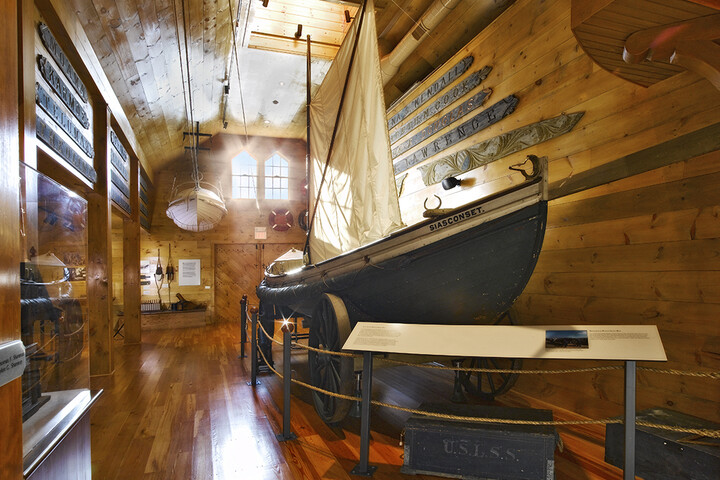
A beloved artifact in the Shipwreck & Lifesaving Museum's Shannon Gallery is the wooden surf boat, Siasconset, that served the island as part of the Massachusetts Humane Society in1914. Eighty-one years after serving the island, the surf boat returned to Nantucket.
Maurice Gibbs facilitated the homecoming of Siasconet while he served as the Museum Director in 1995. It was a benchmark moment for the museum, and it is with great pride that we share the story with you today.
Article transcription is below:

Nantucket recaptures a piece of its maritime history
By Joshua Balling
A valuable piece of Nantucket's maritime history has finally found its way home.
The 23-foot wooden surf boat Siasconest, one of only three such vessels in existence, was unveiled at the Nantucket Lifesaving Museum Thursday after spending more than half a century landlocked in Michigan.
The surf boat made its last rescue off Nantucket's eastern shore for the Massachusetts Humane Society in 1914. It was purchased by Edsel Ford, a summer visitor to the island [and] the son of Ford Motor Co. founder Henry Ford.
Despite numerous attempts to bring it back to Nantucket, the boat has languished at the Henry Ford Museum in Dearborn, Mich. for the last 59 years, Lifesaving Museum Director Maurice Gibbs said on Monday.
"Edouard Stackpole, [one of] the founder[s] of the museum, always wanted the boat back where it belongs," Gibbs said. "The week of his memorial service this year, they offered it to us. It was only fitting."
The long white boat, which Gibbs said is in mint condition although it looks "tired and dirty," will be restored to its original immaculate condition this winter by U.S. Coast Guard Senior Chief Jack Downey and the rest of Coast Guard Station Brant Point. It will remain a permanent piece of the museum's unique collection of Nantucket lifesaving and shipwreck relics.
When you see it in the museum, you'll be looking at a fantastic piece of history," Gibbs said. "It means a lot to have it. There are very few remnants left of the old Life Saving Service, not to mention the Humane Society." The Massachusetts Humane Society preceded not only the U.S. Coast Guard but also the U.S. Lifesaving Service in rescuing victims of shipwrecks and other coastal accidents and mishaps.
The first Humane Society lifesaving station was established on Nantucket in the early 1800s. Soon thereafter, outposts were also set up in Quidnet, Siasconset, Tom Nevers, Forked Pond - now known as Dionis - and Madaket, known then as Great Neck, Gibbs said.
The wooden boats were primary means of performing rescues in Nantucket's treacherous surf, he added.
"The great quandary in those days was designing a boat that you could withstand rough water and you could bring somebody back in, but was light enough for six men to carry across the beach," Gibbs said. "This boat is actually a little lighter than the boats used years later by the Lifesaving Service."
After the Lifesaving Service was founded in 1871, it coexisted with the Humane Society for nearly 40 years. The Humane Society finally decided to give up its posts on Nantucket, Gibbs said. "The Humane Society just wasn't needed anymore," he said. "The Lifesaving Service was here, and there weren't nearly as many shipwrecks because we had switched largely from sail to steam. The Humane Society decided to put most of its equipment up for bid."